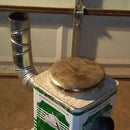Introduction: SHOP OVEN
SHOP OVEN
One thing those of us who tinker, or think of our selves as introverted geniuses need is a source of controllable heat. The family doesn't like the idea of us using the kitchen oven for our projects, so what do we do? We convert a microwave oven to a regular oven. How you say? We gut out a big microwave oven and put the guts of a toaster oven in it.
Years ago I needed plastic for a project and bought a piece of ABS plastic. Almost cost me one of my family jewels for a 48"x36" piece. Still have some of it, been using it sparingly. What is one to do. Everyone is doing renovations, pieces of ABS pipe in the dumpster, the curbside, as well as PVC gutter. The light bulb goes on in your little lunatic mind and the idea pops out. MICROWAVE OVEN + TOASTER OVEN = SHOP OVEN and you happen to have both in your stock pile inventory. The stock pile your family has threatened you with an INTERVENTION!!!! YUK YUK YUK
MATERIALS USED
1 x dead microwave oven
1 x abused toaster oven
some oven wire - HIGH TEMP- the stuff with braiding
oven connectors- HIGH TEMP
some sheet metal
some metal screws
some wire mesh
and other assorted things as needed
TOOLS
drill - cordless or corded will do
drill bits
pliers
metal shears
screw drivers
hammer
Step 1: THE BUILD
Start by tearing the guts out of the microwave oven as per pictures. Careful do not damage the shell. Next carefully open the toaster oven and make notes of how it is wired (did not have smart phone back then) take pictures. Many as the toaster guts are important for the project. Disassemble toaster oven carefully. Put controls and heating elements in safe place and scrap the other stuff er (RECYCLE IT).
Step 2: Supports for the Elements
Once you are confident and happy with the results start building the supports for the elements. DANGER! DANGER! WARNING- the elements use 110volts AC.
Step 3: Wiring, Testing, and Completion
Wire up the elements with oven wire - HIGH TEMP- the stuff with braiding as per pictures you took, and add the controls. ADD the wire mesh around the elements to keep material from touching them. TEST RUN the oven. That is make sure controls are in OFF position, PLUG it in, with all TEMP controls on lowest setting turn Frankenstein on and check for life with the ON light. If if lights slowly turn the TEMP control just a bit. NO SPARKS!!!! YEAH you have a shop oven. No light, pull plug, NO SWEARING here after all you are a GENIUS. Remember WILLY COYOTE!!! Be cerebral, GET DRUNK or STONED whichever you prefer.
You know what they say about assume - you make an ass of U and ME. But assuming Frankenstein er (OVEN) is alive and working put the cover back on.
YOU NOW HAVE YOUR OWN SHOP OVEN. No more family screaming it stinks in here, you burned your project in the kitchen oven.
The idea here is when softening plastics to flatten them SLOW and LOW TEMPS is the WAY. See in the oven picture a piece of PVC gutter ready for softening.
Step 4: Final Thoughts on This Project
I started out with on toaster oven and finished a different kind. There must have been something about the guts I didn't like or I destroyed the original.
What counts is the final result "Frankenstein WORKS"
PS:
Regarding me
For a guy who doesn't like the heat, my projects all seem to be heat related. The next few are all heat related. What do you think maybe create another user called "HEATMEISTER". YUK YUK YUK! LOL











